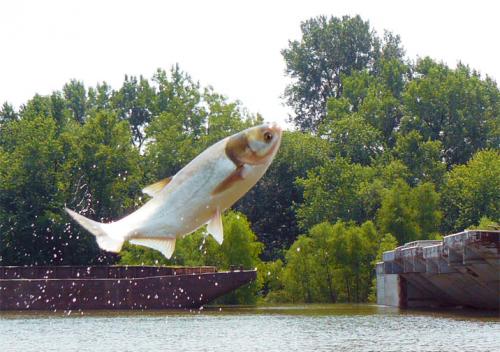Understanding options for stopping Asian carp in the Great Lakes
Eight options for aquatic nuisance species prevention are listed in the recent GLMRIS report. Two of these involve dams that would restore the natural divide between the Great Lakes and Mississippi River basins in Chicago.
The United States Army Corps of Engineers (USACE) is now considering eight options identified in the Great Lakes Mississippi Interbasin Study (GLMRIS). Public comments are being accepted until March 3.
If you want to stop Asian carp and other aquatic nuisance species (ANS) from accessing the Great Lakes through Chicago area waterways, it is important to understand the GLMRIS options before commenting. In your comments, make sure to reference the specific option that you prefer. This will leave no room for doubt when interpreting  public input at the end of the comment period.
public input at the end of the comment period.
A brief overview of each Alternative Plan follows; more specifics are available in a 28-page summary and the full GLMRIS report.
Alternative Plan 1: No new federal action.
If you think that current efforts that include electric barriers and removal netting are sufficient, this is the option for you. There are costs associated with current actions, but this is the baseline condition to which other alternatives are compared.
Alternative Plan 2: Nonstructural control technologies.
This plan involves additional netting, chemical control, watercraft inspection, and education efforts in multiple states but does not involve additional structures to separate waterways. The estimated additional cost is $68 million annually, and this option could be pursued in addition to other options.
Alternative Plan 3: Control technologies without buffer zone.
This option involves $9.1 billion in flood mitigation and two structures dubbed “GLMRIS Locks.” The GLMRIS locks allow navigation to continue and do not achieve hydrologic separation. Instead, these locks would operate in conjunction with pumps and water treatment facilities to provide some measure of control specific to ANS that drift passively through the waterways. The price tag for these ANS control measures along with two additional electric barriers is $4 billion and the estimated additional cost of this alternative is $15.5 billion.
Alternative Plan 4: Control technology with buffer zone
This option involves GLMRIS locks and electric barriers at three locations different from those proposed in Alternative 3. Flood mitigation costs (~$2 billion) are less than Plan 3 and the estimated additional cost is $7.8 billion.
Alternative Plan 5: Lakefront hydrologic separation
Four physical barriers located in canals near Lake Michigan are used to restore the natural divide in this plan. Water from Lake Michigan would be treated in ANS treatment plants before being released in CAWS canals to flush Chicago area runoff and Combined Sewer Overflow effluent downstream. This option includes $14.4 billion in flood mitigation because runoff from heavy rains would no longer be drained into Lake Michigan. The cost of barriers and other ANS controls is $446 million and the total additional cost estimate is $18.4 billion.
Alternative Plan 6: Mid-system hydrologic separation
Physical barriers placed near the midpoint of two canals achieve basin separation in this plan, which also incorporates ANS treatment plants and conveyance tunnels to use Lake Michigan for maintenance of water quality in the CAWS. The cost of barriers is $223 million, while the cost of water quality mitigation is over $12.8 billion. Total estimated additional cost is $15.2 billion.
Alternative Plan 7: Calumet-Sag Channel Open Control “hybrid”
This plan places a physical barrier on the Chicago Sanitary and Ship Canal but leaves the Cal-Sag open for navigation between basins via GLMRIS lock. Total estimated additional cost is $15.1 billion.
Alternative Plan 8: Chicago Sanitary and Ship Canal Open Control “hybrid”
This option is the reverse of Plan 7, leaving the Chicago Sanitary and Ship Canal open to navigation and without hydrologic separation. Total estimated additional cost is $8.3 billion.
Now that design options and cost estimates are officially on the table, Great Lakes advocates, industry representatives and taxpayers can take the time to register an informed opinion. If you decide to comment, be sure to reference the Alternative Plan you prefer; even if you do go on to voice concerns about certain design aspects, costs, or funding sources for implementation.
For additional information on Asian carp, see previous Michigan State University Extension news articles on hydrologic separation, emerging science, and control options.



 Print
Print Email
Email

